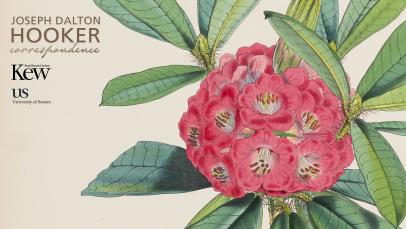JDH describes arrival at Point de Galle 31 Dec. Compares Cape Comorin, Cape of Good Hope & Cape Horn. Met by [George] Gardner [GG] with invitation from Lord Torrington to visit Candy [Kandy] but no time. Describes native peoples. Notes Thespesia populnea, Jack & Mango trees, & valuable timbers. Walked wooded lanes with GG, reminded of Amsterdam & Lyden. Showed GG home similar to Hartecamp, Linnaeus’ residence. Lists plant species in damp, very wet & dryer areas. Names fern species & common weeds, tropical roadside genera & palms. Discusses useful plants; Sonneratia acida wood for boxes, Terminalia catappa embryo eaten for dessert, Ficus demonum [F. daemonum] leaves to polish wood, & Artocarpus pubescens. Lists shrubs & small trees. Few parasites & epiphytes. Widespread Passiflora foetida introduced 1824, Bryophyllum & Allamanda cathartica. Discusses relationship between phosphorescent insects & humidity observed in Madras [Chennai], Calcutta [Kolkata], Behar, Birbhoom, Shahabad, Mizrapore & Darjeeling. Mosses fairly represented, algae very rare, lichens abundant. Bid farewell to Matilda. JDH uncertain he will visit Ceylon [Sri Lanka] again. Collected Trimeriza. Visited house with beautiful carved curiosities & jewels. Reminded of Professor Miller of Cambridge. Arrived Madras with GG, 5 Jan. Describes Lord Dalhousie’s military reception & vast number of natives in welcoming party. Met various knowledgeable people while staying with Lord Tweeddale. Walter Elliot directed him to Buddhist antiquities. Discusses winged lion familiar from Syrian marbles & sketches by Walter Forbes. [Brian Houghton] Hodgson says they are evidence of Asian origin of the Buddhist religion. In another letter JDH will show how the physical geography has indicated the positions of the tribes of people as well as plants, & has regulated their migration. Spent a long time with WE at botanic garden under care of Captain Worcester'. Describes garden.

The Joseph Dalton Hooker Collection
The Joseph Dalton Hooker Correspondence Project at Kew is making available online the personal and scientific correspondence of the botanist and explorer Sir Joseph Dalton Hooker (1817–1911), Director of the Royal Botanic Gardens’ Kew from 1865-1885. The project was conceived by staff of The University of Sussex and Kew's Library, Art and Archive department and began as a partnership between Kew and the University of Sussex's Centre for World Environmental History. It has been made possible by support from the Stevenson Family Charitable Trust. Letter summaries can be searched through Ɛpsilon, with links to images and transcriptions at the project site at Kew (https://www.kew.org/explore-our-collections/correspondence-collections/joseph-hooker-collections).